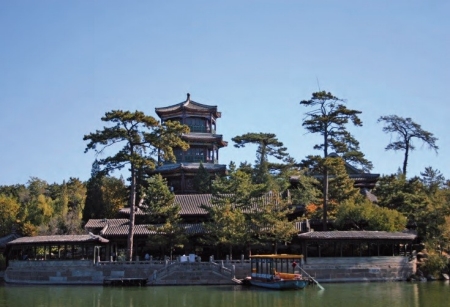Relatively little now remains attesting to the Kangxi emperor’s conception for Bishu shanzhuang or his realization of it. Among the few surviving testaments to the site’s earliest years is a two-volume work produced by the court, Thirty-Six Imperial Poems on Bishu shanzhuang (Yuzhi Bishu shanzhuang shi). Published in parallel Chinese- and Manchu-language editions in 1714, Thirty-Six Imperial Poems paired images of the Mountain Estate’s most scenic sites with imperial poems describing the emperor’s life within its walls. Part autobiography, part political manifesto, part lyric account of a personal landscape, Thirty-Six Imperial Poems offered its privileged recipients virtual access to the emperor’s private estate and to the emperor himself.
As this year draws to a close, I am completing work on a coauthored translation and study of Thirty-Six Imperial Poems, to be published by Dumbarton Oaks in 2014. The volume will present translations of both the Chinese and the Manchu texts—the largest trilingual publication of its kind ever undertaken and a critical contribution to scholarship on the multilingual Qing empire—together with several other early accounts of the Mountain Estate. Alongside these will be reproductions of both the original woodcut views and those of a subsequent copperplate edition produced for the court under the direction of the Italian missionary Matteo Ripa (1682 – 1746). Ripa’s copperplates are the earliest known use of European printing technology in China, as well as the first images of Chinese gardens to reach Europe. As such, they represent important monuments in the intellectual, cultural, and technological exchanges of the eighteenth century on opposite ends of the Eurasian continent.
Previous scholarship concerning Bishu shanzhuang has focused largely on its later states of development, attained under Kangxi’s grandson, the Qianlong emperor (r. 1735–1795). An underlying goal of my research has to been to recover its earliest history through an emphasis on Kangxi sources, reconstructive mapping, and other intentional methodologies. Through these approaches, I aim not only to uncover how the Kangxi and Qianlong emperors differed as garden builders, but, as a more important goal, to create a diachronic history of Bishu shanzhuang that may be effectively engaged as a source in understanding differences between the emperors and the periods of their respective reigns. Articulating these concerns and methods is the focus of my second major project for the year, “From Upper Camp to Mountain Estate: Recovering Historical Narratives in Qing Imperial Landscapes,” an essay to be published in Studies in the History of Gardens and Designed Landscapes in early 2014.
The shadow cast over Qing imperial history by the Qianlong emperor extends beyond Bishu shanzhuang, however, and a concern with recovering distinctive aspects of Kangxi court art is also at the center of my third major project for the year, an essay entitled “Towards a Qing Synthesis: Wang Yuanqi (1642–1715) and Early Qing Court Painting.” Through careful visual analysis of several monumental landscape paintings from the last fifteen years of Wang Yuanqi’s life, during which time he was the most important painter and art theorist in the Qing court, I seek to clarify the stylistic origins and early development of the distinctive Qing court painting style, thereby advancing our understanding of the Manchu court’s engagement with Chinese and European pictorial traditions circulating at that time. The essay is part of a group focusing on Qing visuality entitled “Images and Imaginaries: A Connective History of Qing Visual Art,” of which I am coeditor; they are expected to form a thematic issue of Archives of Asian Art in spring 2014.
Having spent much of this year writing about representations of the Mountain Estate, during the second year of my fellowship I will turn to the physical landscape itself. With support from CASVA, the Andrew W. Mellon Foundation, and the Society of Architectural Historians, I will spend the summer geotagging and photographing Bishu shanzhuang, creating a dataset that will permit mapping and geospatial analysis of the site, important next steps in my efforts to uncover its earlier histories.
